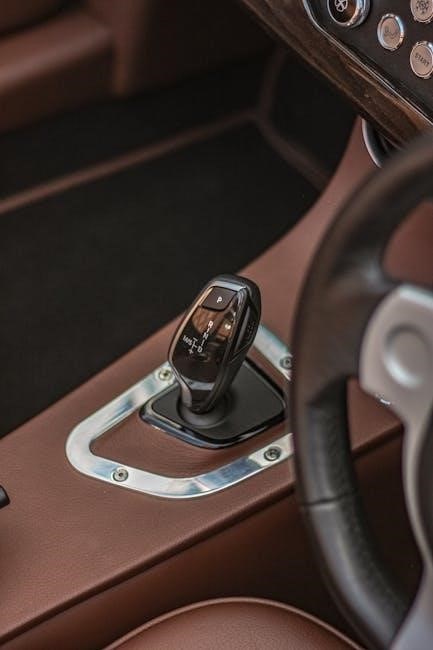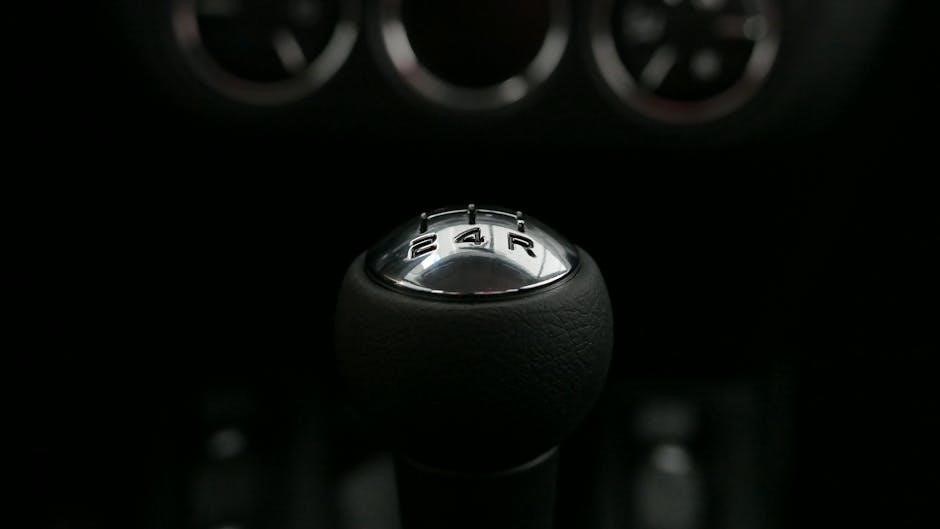The Subaru Outback manual transmission offers a unique blend of performance, fuel efficiency, and driving engagement, making it a beloved choice for enthusiasts seeking control and connection behind the wheel․
1․1 Overview of the Subaru Outback
The Subaru Outback is a mid-size SUV known for its all-wheel-drive capability and versatile design, blending the practicality of a wagon with the ruggedness of an SUV․ Introduced as a trim level of the Subaru Legacy, it has since become a standalone model, offering a range of engine options, including the 2․5L and 3․6L variants․ The Outback has been praised for its reliability, spacious interior, and off-road prowess․ Over the years, it has evolved to include advanced safety features and technological upgrades while maintaining its reputation as a durable and dependable vehicle for both on-road and off-road adventures․
1․2 Importance of Manual Transmission in the Subaru Outback
The manual transmission in the Subaru Outback plays a crucial role in delivering a driving experience that combines control, engagement, and efficiency․ For enthusiasts, it offers precise gear shifts and a direct connection to the vehicle, enhancing both on-road performance and off-road capability․ The manual option is particularly valued for its fuel efficiency and cost-effectiveness compared to automatic transmissions․ Additionally, it appeals to drivers who prefer an active role in driving, making it a standout feature in Subaru’s lineup․ Despite the industry’s shift toward automatics, Subaru has historically supported manual transmissions, catering to a niche of passionate drivers who prioritize driving involvement and mechanical simplicity․

History of Manual Transmission in the Subaru Outback
The Subaru Outback’s manual transmission traces its roots to earlier Legacy models, evolving over decades to enhance performance and driver engagement before its decline in newer models․
2․1 Early Models with Manual Transmission
The Subaru Outback’s manual transmission debuted in its early years, derived from the Legacy series․ The 2000 Outback featured a 5-speed manual, offering precise control and fuel efficiency․ By 2010, a 6-speed manual became available, enhancing driver engagement․ These models catered to enthusiasts seeking a more connected driving experience, blending performance with practicality․ The manual transmission played a key role in the Outback’s identity, especially in its earlier iterations, before its gradual decline in later years․
2․2 Evolution of Manual Transmission in the Outback
The Subaru Outback’s manual transmission evolved significantly over the years․ Early models featured a 5-speed manual, while later iterations introduced a 6-speed unit for smoother shifting and better fuel efficiency․ By 2015, manual transmissions were discontinued in the Outback, reflecting broader industry trends․ However, Subaru continued to cater to enthusiasts by reintroducing manual modes in newer models, such as the 8-speed manual mode in the 2024 Impreza․ This shift highlights Subaru’s commitment to balancing tradition with innovation, ensuring driver engagement remains a priority for its vehicles․
Key Features of the Subaru Outback Manual Transmission
The Subaru Outback manual transmission offers a 6-speed system, providing smooth shifting and precise control․ Its lightweight design enhances fuel efficiency and delivers reliable performance across varying terrain․
3․1 Overview of the Manual Transmission System
The Subaru Outback manual transmission system is a 6-speed gearbox designed for precise control and smooth shifting․ It features a lightweight construction, enhancing fuel efficiency and reliability․ The system integrates seamlessly with Subaru’s all-wheel-drive technology, ensuring optimal power distribution and traction; Drivers benefit from a responsive clutch and intuitive gear ratios, making it suitable for both urban and off-road driving․ This setup emphasizes driver engagement while maintaining the practicality expected from the Outback․ The manual transmission is a key feature for enthusiasts, offering a direct connection to the vehicle’s performance and handling capabilities․
3․2 Clutch System and Functionality
The Subaru Outback manual transmission features a responsive clutch system designed for smooth engagement and disengagement․ The clutch pedal offers a lightweight feel with clear feedback, making it easy to operate in both city driving and off-road conditions․ A self-adjusting hydraulic clutch ensures consistent performance over time, reducing maintenance needs․ The system is engineered to provide precise control, allowing drivers to shift gears seamlessly․ This functionality enhances the overall driving experience, offering a perfect balance of comfort and responsiveness․ The clutch system is integral to the manual transmission’s appeal, delivering a direct connection between driver input and vehicle performance․
3․3 Gearbox and Shifting Mechanism
The Subaru Outback manual transmission features a robust gearbox designed for durability and smooth gear transitions․ The shifting mechanism is precise and responsive, offering drivers a seamless experience․ With a focus on driver engagement, the gearbox is engineered to handle torque effectively, ensuring optimal power delivery․ The shifting mechanism’s short throw and clear gates enhance the driving experience, making it a favorite among enthusiasts․ This system is crafted to provide both efficiency and enjoyment, catering to those who value the connection of manual driving in the Subaru Outback․
Benefits of the Manual Transmission in the Subaru Outback
The manual transmission enhances fuel efficiency, driving engagement, and control, making it a cost-effective and enthusiast-friendly option for Subaru Outback drivers seeking a connected experience․
4․1 Improved Fuel Efficiency
The Subaru Outback manual transmission offers improved fuel efficiency by allowing drivers to maintain optimal engine RPMs, reducing unnecessary fuel consumption․ This driver-controlled gear shifting ensures better MPG, especially in city driving and hilly terrain․ Unlike automatic transmissions, manuals typically weigh less and have fewer parasitic losses, contributing to higher efficiency․ Many owners report real-world mileage improvements, particularly in models like the 2012 Outback 2․0D, where manual transmission enhances eco-friendly performance without sacrificing power․
4․2 Enhanced Driving Engagement
The Subaru Outback manual transmission enhances driving engagement by offering precise control over gear shifts, allowing drivers to feel more connected to the vehicle․ This direct interaction fosters a sense of involvement, particularly on winding roads or during spirited driving․ The tactile feedback of the clutch and shifter creates a more immersive experience, making every drive feel intentional and rewarding․ Enthusiasts appreciate the ability to optimize power delivery, especially in varying terrain, which heightens the overall driving satisfaction and connection to the road․

Manual vs․ Automatic Transmission in the Subaru Outback
The Subaru Outback offers both manual and automatic transmissions, catering to different driving preferences․ Manual transmissions provide better fuel efficiency and a more engaging driving experience, while automatics offer convenience and smoother operation in traffic․ Each option has its unique benefits, appealing to distinct lifestyles and priorities․
5․1 Comparison of Performance
The Subaru Outback’s manual transmission delivers enhanced fuel efficiency and a more engaging driving experience, allowing drivers to maximize control and connection with the road․ Automatic transmissions, while offering convenience and smoother acceleration, may lack the direct responsiveness of their manual counterparts․ Performance-wise, manual transmissions often provide quicker acceleration and better handling, particularly in off-road conditions, due to the ability to manually select gears․ However, automatics excel in stop-and-go traffic and ease of use․ The choice between the two ultimately depends on the driver’s priorities, whether emphasizing driving engagement or everyday convenience․
5․2 Driver Preference and Use Cases
Driver preference for the Subaru Outback manual transmission often stems from a desire for greater control and driving engagement․ Enthusiasts appreciate the tactile experience of shifting gears, which enhances connection to the vehicle, especially on winding roads or off-road terrain․ Manual transmissions are also favored by those who prioritize fuel efficiency and cost-effectiveness, as they typically offer better mileage and lower maintenance costs compared to automatics․
For city driving or heavy traffic, automatic transmissions are generally preferred for their convenience and ease of use․ However, manuals remain popular among purists and adventurers who value precision and responsiveness in varying conditions․

Technical Specifications of the Subaru Outback Manual Transmission
The Subaru Outback manual transmission features a 6-speed system, compatible with 2․5L and 3․6L engines, ensuring smooth shifting and optimal performance across various model years;
6․1 Engine Compatibility
The Subaru Outback manual transmission is compatible with both the 2․5L 4-cylinder boxer engine and the 3․6L 6-cylinder boxer engine, ensuring smooth power delivery and optimal performance․ The 2․5L engine pairs well with the manual transmission for enhanced fuel efficiency, while the 3․6L engine provides greater power output for those seeking a more robust driving experience․ Both engines are designed to work seamlessly with the 6-speed manual gearbox, offering drivers precise control and responsiveness․ This compatibility ensures that the Outback’s manual transmission caters to a wide range of driving preferences and needs․
6․2 Transmission Specifications by Model Year
Subaru Outback manual transmissions vary by model year, with the 6-speed manual gearbox being a common feature across multiple generations․ In 2012, the Outback featured a 6-speed manual paired with the 2․5L engine, offering smooth shifting and improved fuel efficiency․ The 2014 model year saw similar specifications, with the manual transmission remaining a popular choice for its engaging drive․ However, after 2015, Subaru phased out the manual option in favor of automatic and CVT transmissions․ While newer models no longer offer a manual, enthusiasts can still find compatible transmissions for older Outbacks, ensuring the legacy of manual driving lives on․
6․3 Drivetrain and AWD System Integration
The Subaru Outback manual transmission seamlessly integrates with its Symmetrical All-Wheel Drive system, optimizing power distribution between front and rear wheels for enhanced traction and stability․ This integration ensures superior handling on various terrains, from paved roads to off-road adventures․ The manual gearbox allows drivers to maintain control over shifting, further enhancing the connection between the vehicle and driver․ This synergy between the drivetrain and AWD system is a hallmark of the Outback’s design, providing both performance and reliability in diverse driving conditions while maintaining the signature Subaru capability and responsiveness․

Maintenance and Repair of the Manual Transmission
Regular maintenance, including fluid checks and clutch inspection, ensures optimal performance․ Repairs often require genuine Subaru parts and skilled technicians to maintain reliability and durability․
7․1 DIY Maintenance Tips
Regular DIY maintenance for the Subaru Outback manual transmission includes checking transmission fluid levels, inspecting the clutch pedal for smooth operation, and monitoring gear engagement․ Owners can replace the clutch master and slave cylinders if leaks or wear are detected․ It’s also important to listen for unusual noises during shifting, as they may indicate worn synchros or bearings․ Replacing the transmission filter and flushing the fluid every 30,000 miles can prevent contamination and extend lifespan․ Always use genuine Subaru parts to ensure compatibility and reliability․ If issues persist, consulting a professional mechanic is recommended to avoid further damage․
7․2 Common Issues and Troubleshooting
Common issues with the Subaru Outback manual transmission include clutch master or slave cylinder leaks, worn synchros, and noisy bearings․ If the clutch pedal feels spongy or engagement is inconsistent, inspect for fluid leaks or worn components․ Grinding gears may indicate improper clutch use or low transmission fluid levels․ Noisy bearings can signal wear and require replacement․ For troubleshooting, check fluid levels, ensure proper clutch operation, and inspect for leaks․ If issues persist, professional diagnosis is recommended to prevent further damage․ Addressing these problems early ensures smooth operation and extends the transmission’s lifespan․
7․3 Cost of Repair and Replacement
The cost of repairing or replacing the Subaru Outback manual transmission varies depending on the issue and model year․ DIY repairs for minor issues, like replacing the clutch or seals, can range from $200 to $500․ Professional repairs for more complex problems, such as faulty synchros or bearings, can cost between $800 and $2,000․ Full transmission replacement, including labor, typically ranges from $2,500 to $4,000․ Prices may increase for newer models or if genuine Subaru parts are required․ Regular maintenance and early issue detection can help reduce long-term costs and prevent major repairs․
Driving Experience with the Subaru Outback Manual Transmission
The Subaru Outback manual transmission delivers a driving experience that combines performance, fuel efficiency, and enhanced engagement, offering drivers precise control and a connected feel․
8․1 On-Road Performance
The Subaru Outback with a manual transmission excels on-road, offering precise control and responsiveness․ Drivers can enjoy smooth shifting and optimal gearing for both city and highway driving․ The manual transmission enhances fuel efficiency and provides a more engaging driving experience․ Enthusiasts appreciate the direct connection to the vehicle, making every commute or road trip more enjoyable․ The Outback’s manual transmission is particularly praised for its ease of use and reliability, ensuring a smooth ride while maintaining the car’s adventurous spirit․ It remains a preferred choice for those who value hands-on driving and the thrill of the open road․
8․2 Off-Road Capability
The Subaru Outback’s manual transmission shines off-road, where precise control and low-speed torque management are essential․ The car’s Symmetrical All-Wheel Drive system, combined with the manual gearbox, ensures optimal power delivery on uneven terrain․ Drivers can modulate acceleration and maintain traction effortlessly, even in challenging conditions․ The Outback’s generous ground clearance and robust design further enhance its off-road prowess․ Whether navigating rocky trails or muddy paths, the manual transmission provides the driver with the confidence and control needed to tackle adventures with ease, making it a reliable companion for both on-road and off-road excursions․
Buyer’s Guide for Subaru Outback with Manual Transmission
When purchasing a Subaru Outback with manual transmission, consider model years up to 2015, ensuring excellent AWD performance and checking for optimal condition and mileage․
9․1 Recommended Model Years
For the Subaru Outback with manual transmission, the 2010-2015 model years are highly recommended․ These models, such as the 2010 2․5i and 2012 2․0D Premium, offer a reliable 6-speed manual gearbox, providing excellent driving engagement and fuel efficiency․ The 2014 Outback 2․5i Premium is another standout option, featuring a well-refined transmission system․ These years strike a balance between performance, affordability, and resale value, making them ideal for buyers seeking a manual Outback․ Ensure the vehicle has been well-maintained, as later models phased out the manual option, increasing the appeal of these earlier editions․
9․2 What to Look for When Purchasing
When purchasing a Subaru Outback with a manual transmission, prioritize the condition of the clutch and gearbox․ Check for smooth shifting and any signs of wear or grinding․ Review maintenance records to ensure regular servicing of the transmission and clutch system․ Test drive the vehicle to assess the clutch pedal feel and gear engagement․ Also, verify the compatibility of the manual transmission with the engine type, as some models may have specific configurations․ Lastly, consider the vehicle’s mileage and history, as high mileage or improper use can affect transmission longevity․ A thorough inspection by a mechanic is highly recommended․
The Decline of Manual Transmission in the Subaru Outback
The Subaru Outback’s manual transmission has been phased out in later models, reflecting a broader market shift toward automatic and CVT options, catering to modern driver preferences․
10․1 Discontinuation of Manual Transmission in Later Models
The Subaru Outback’s manual transmission was gradually phased out in later models, with the last manual option available in the 2015 model year․ This shift aligns with broader industry trends favoring automatic and CVT transmissions for their convenience and smoother operation․ Subaru, like many automakers, prioritized meeting market demand for effortless driving experiences, especially in SUVs and crossovers․ The discontinuation reflects declining consumer interest in manual transmissions, as modern drivers increasingly value ease and comfort over manual control․ This change has been met with nostalgia from enthusiasts but aligns with Subaru’s strategy to modernize its lineup․
10․2 Market Shift Towards Automatic Transmissions
The automotive industry has seen a significant shift toward automatic transmissions, driven by consumer demand for convenience and ease of use․ Subaru, like many manufacturers, has responded by prioritizing automatic and CVT options in its lineup․ The decline in manual transmission sales, particularly in SUVs and crossovers, has led Subaru to focus on these more popular alternatives․ While manual transmissions remain beloved by enthusiasts, the broader market preference for smooth, hassle-free driving experiences has made automatics the dominant choice․ This trend underscores the evolving needs of modern drivers, who increasingly value comfort and practicality over manual control․
The Subaru Outback manual transmission stands as a testament to driving purism, offering unmatched control and engagement, even as the automotive world leans toward automatics for convenience․
11․1 Final Thoughts on the Subaru Outback Manual Transmission
The Subaru Outback manual transmission remains a timeless choice for driving enthusiasts, blending performance, efficiency, and tactile engagement․ Despite the industry’s shift toward automatics, Subaru has historically catered to purists by retaining manual options in its lineup․ The Outback’s manual gearbox, particularly in earlier models, delivers a connected driving experience that fosters a deeper bond between driver and vehicle․ While newer models have phased out manual transmissions, the legacy of these systems endures, making them sought after by collectors and enthusiasts who value the art of manual driving in a capable, versatile SUV․
11․2 Future Prospects for Manual Transmissions in Subaru
While manual transmissions are becoming less common, Subaru has historically supported enthusiasts by offering them in select models․ However, recent trends suggest a decline, with manuals discontinued in the Outback after 2015 and the Forester after 2018․ Despite this, Subaru may revisit manual options in future models, especially if demand persists among driving purists․ The development of advanced driver-assistance systems like EyeSight for manual transmissions could pave the way for their return․ Enthusiasts remain hopeful Subaru will continue to cater to those who value the tactile experience of manual driving, ensuring its legacy in the brand’s lineup․
Frequently Asked Questions (FAQs)
FAQs about the Subaru Outback manual transmission cover reliability, availability, and resale value, providing clarity for enthusiasts and buyers interested in this unique drivetrain option․
12․1 Is the Subaru Outback Manual Transmission Reliable?
The Subaru Outback manual transmission is known for its reliability, with many owners reporting low maintenance needs and consistent performance․ Models like the 2012 and 2010 Outback with manual transmissions have shown durability, especially when properly maintained․ The drivetrain integrates well with Subaru’s AWD system, enhancing traction and control․ Regular clutch and gearbox checks are essential to ensure longevity․ While issues can arise, they are often due to wear and tear rather than systemic faults․ Overall, the manual transmission in the Outback remains a dependable choice for enthusiasts seeking a hands-on driving experience․
12․2 Can I Still Buy a New Subaru Outback with Manual Transmission?
As of recent model years, the Subaru Outback no longer offers a manual transmission option in its new lineup․ Subaru has shifted focus toward automatic and CVT transmissions to align with technological advancements and market demand․ While manual transmissions were available in earlier models, such as the 2010 and 2012 Outback, they have since been discontinued․ Enthusiasts seeking a manual Outback may need to explore used or certified pre-owned options to find a model with this feature․
12․3 How Does the Manual Transmission Affect Resale Value?
The manual transmission in a Subaru Outback can influence resale value, often appealing to driving enthusiasts who value the unique driving experience it provides․ While it may attract niche buyers, the broader market shift toward automatic transmissions could limit its appeal․ Well-maintained manual Outbacks, particularly older models, tend to retain value better than their automatic counterparts, as they cater to a specific audience seeking control and engagement․ However, in regions where automatics dominate, resale value might be slightly lower due to reduced demand for manual transmissions․
